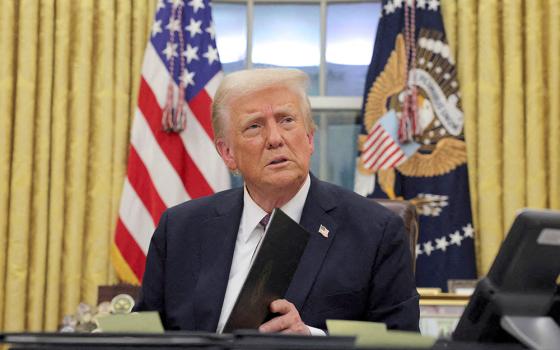“Welcome to this beautiful border!” Bishop Ricardo Ramirez said to the crowd. “Why is this border so beautiful? Because of the people of faith who live along the border! This border is full of people of faith. So we gather to celebrate this faith, and nothing can take this faith from us -- no weapons, no guns, no unjust immigration laws. Our hearts are filled with love for one another. This faith and this love are our consolation.”
So began the annual “Mass for the Dead” along the tall, chain link fence marking the U.S.-Mexico border near El Paso, Texas last Tuesday, Nov. 2.
Bishop Ramirez of the Diocese of Las Cruces, N.M., invited me to join him for the day on the border, so we drove down to a remote place in the hilly desert where the long chain link fence divides the barren land. Hundreds of people, perhaps nearly a thousand, made their way as well to attend the Mass. Armed Border Patrol guards stood among the crowd and along the fence, keeping an eye on everyone.
Was it one Mass or two Masses, I asked the bishop, trying to understand. It’s one Mass, he said, with two tables placed on either side of the fence. Mexicans sat on one side, U.S. citizens on the other.
“We pray today for all the victims of violence, for all our young who have died, all those killed by drug violence, all those who died trying to cross the border,” Bishop Ramirez said.
 |
Bishop Ramirez will offer a talk on 'Eucharist without Borders' at Celebration's Conference on Effective Liturgy: A Light to the Nations: Comprehensive Immigration Reform and the Church’s Global Commitment to the Poor. |
Indeed, that was why everyone had come — to mourn and pray for the thousands who have died from drug war violence and from trying to cross the border. I met many people on both sides of the fence who give their lives serving these suffering, struggling, dying people. One priest told me about three youths who were stoned to death a few days earlier. He himself had picked up and moved the blood-stained rocks. A nun told me about a little boy who was shot and killed the other day, caught in the crossfire. There seems to be no end to the violence, they said, and no vision or leadership to help end it.
“We are trying to figure out how to practice nonviolence and teach nonviolence to the suffering people of Jaurez, Mexico,” one peacemaking nun told me while standing by the fence. “We are surrounded by violence, but we want to be a presence of nonviolence.” We spoke of how the church could help by lifting up the vision of peace, encouraging everyone to get rid of their guns, teaching nonviolence and helping to create a nonviolent Jaurez and a nonviolent border-land.
The hot sun beat down upon us. It was a typical day in the desert, except for this great coming together on all sides. “We have come to share our common dream,” Bishop Ramirez said in his sermon. “Our common dream is the reign of God. The reign of God is the dream of God for the world, a new world of justice, love and peace.”
“But what do we see?,” he asked. “An ugly fence! We can’t even embrace in friendship and love because of this fence. Our dream is that one day there will be no fence and we will embrace in friendship and love. What else do we see? We see two tables. We cannot physically take the same bread and cup. Our dream is that one day we will share together the same bread and cup.”
As he spoke, the people sitting in the hot sun took in every word. Many cried. Even the armed guards keeping watch seemed to be listening.
“Our common dream is that we will be united as one family, all daughters and sons of God. One day we will all understand. We dream that one day unjust laws and ugly fences will not separate us. One day we will invite each other to our homes without fear.”
“What else do we see?” He pointed to the top of a nearby mountain, where a large white cross stands looking out over Mexico. “We see the cross of Jesus, and there we find our hope. There our efforts for peace are strengthened. We remember there that love conquers all and never dies. Jesus from the cross dreams of a peaceful world. We must do the same. We may not live to see his dream come true, but we must do what we can for it and trust that one day it will come true because that is the dream of God.”
Bishop Ramirez’s stirring words and gentle spirit made a deep impression. He greeted everyone with a warm welcome. Earlier at his office, I was stunned to see the Catholic Worker art of Fritz Eichenberg lining the hallway, along with large framed posters of Salvadoran Archbishop Oscar Romero and Cesar Chavez, the Latino civil rights and co-founder of the United Farm Workers. Bishop Ramirez seemed to be the last of his kind, a pastoral Vatican II bishop who cares for the poor, serves the migrants and speaks for peace, all with humility and love.
Two weeks earlier, he told me, he had been in Palestine, looking at the evil Israeli wall which separates the people. In two weeks time, he heads off to Colombia, to discuss the effects of trade agreements on the poor. Indeed, for decades he has traveled widely throughout Latin America, building solidarity between our churches. He is a rare, down to earth bishop who tries to make “the dream of God” come true.
The Mass itself seemed to be a bold political act, something Archbishop Romero would have approved of. It reminded me of Masses I have attended in front of the White House, or with the late Archbishop of Recife, Brazil, Dom Helder Camara, in the desert in front of the Nevada Test Site, where the U.S. government tested nuclear weapons. In our prayer, we made public our stand for more just immigration laws and policies, for a world without borders, fences, greed, and violence.
When the time came for the sign of peace, everyone turned toward one another, and then toward the fence. Through the small holes in the links, we touched one another. Many cried. One young U.S. church volunteer, working in Juarez, told me afterwards it was the most moving sign of peace in her entire life.
After communion, we joined in song. As we sang, church workers on the Mexican side released a hundred helium-filled white balloons, each with a red cross on it. The balloons took to the sky and crossed illegally onto the U.S. side. They hovered high above of as we said goodbye to one another. They symbolized our hopes and prayers for a new day when the fence would be torn down, the guns dismantled, the fear would sail away, and we could reach out to one another freely as sisters and brothers.
*****
John’s collection of the writings of Nobel Laureate Mairead Maguire, The Vision of Peace, has just been republished by www.wipfandstock.com. John’s new book, Daniel Berrigan: Essential Writings (Orbis), and other recent books, A Persistent Peace and Put Down Your Sword, as well as Patricia Normile’s John Dear On Peace, are available from www.amazon.com. To contribute to Catholic Relief Services’ “Fr. John Dear Haiti Fund,” go to: http://donate.crs.org/goto/fatherjohn. For further information, or to schedule a lecture or retreat, visit: www.johndear.org.
| Editor's Note: We can send you an e-mail alert every time an On the Road to Peace column is posted to NCRonline.org. Go to this page and follow directions: E-mail alert sign-up. If you already receive e-mail alerts from us, click on the "update my profile" button to add On the Road to Peace to your list. |



